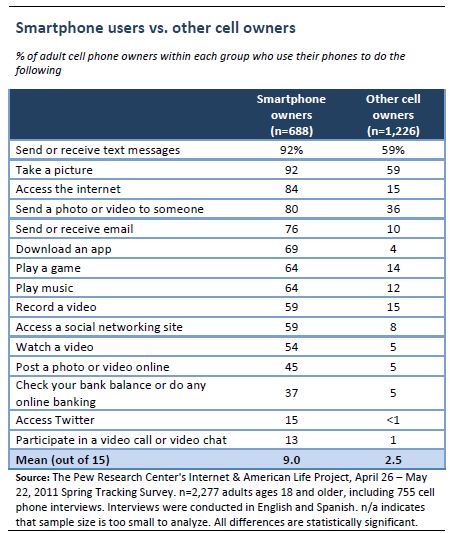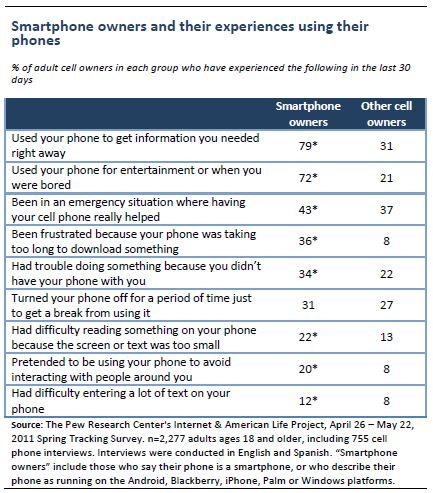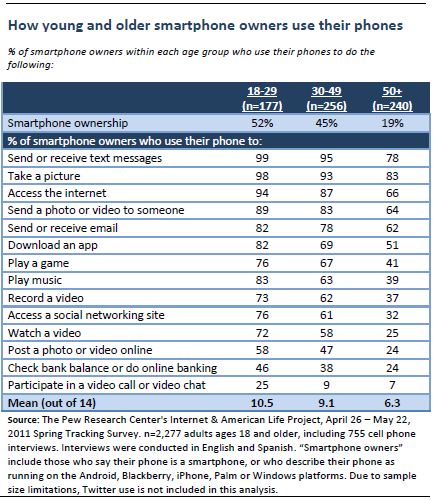One-third of American adults (35%) own a smartphone of some kind as of May 2011, and these users stand in marked contrast to cell owners with more basic devices in terms of how they utilize their mobile devices and incorporate them into their lives.
Picture taking and text messaging are the most ubiquitous functions used by smartphone adopters (92% of smartphone owners do each of these activities, compared with 59% of those with some other type of phone). In addition, eight in ten smartphone owners use their phone to access the internet or send photos or videos to others; three quarters use their phone for email; two thirds download apps or use their phones to play music or games; and six in ten record videos or access social networking sites on their phones. On the other end of the spectrum, just over one in ten smartphone owners use their phones to access Twitter or participate in a video call or video chat.
Compared with smartphone owners, those who own more basic phones use them for a much narrower range of activities (these users engages in an average of just 2.5 activities, compared with an average of nine for smartphone owners). As with smartphone owners, texting and picture taking are the most common activities among owners of more basic phones. Much small numbers use their phones for more advanced functions such as listening to music, playing games or accessing the internet.
Along with using a much wider range of their phones’ capabilities, smartphone owners also stand out in interesting ways from other cell users when it comes to their experiences using their mobile devices:
- Smartphone owners lean heavily on their phones for distraction and quick information retrieval. Fully 79% of smartphone owners say that they used their phones to quickly access information they needed in the 30 days preceding our survey, and 72% used their phone to entertain themselves when they were bored over the same time period.
- On the list of common smartphone frustrations, slow download speeds outpace small screens and tricky text entry. More than one-third of smartphone owners (36%) have become frustrated at slow download speeds on their phones in the preceding 30 days. By contrast, 22% say that they had trouble reading something on their phone over the same time period and just 12% experienced difficulty entering large quantities of text on their phone.
- Smartphone owners can be at a loss without their mobile devices. One third of smartphone owners (34%) have had trouble doing something in the past 30 days because they did not have their phone with them.
- Don’t bother me, I’m on my phone. One in five smartphone owners (20%) say that they have used their phone to avoid interacting with people around them in the preceding 30 days.
While smartphone owners differ dramatically from the rest of the mobile population on almost all measures, there is one area in which smartphone owners did not differ appreciably from other cell owners—turning off their phone just to get a break from using it. Roughly one in three smartphone owners (31%) say that they took a break from using their phone in the preceding 30 days, a figure that is almost identical to the 27% of other cell phone owners who did this over the same time period.
Smartphone owners of all age groups are intense users of their mobile phones
Compared with those under the age of 50, older adults have relatively low rates of smartphone adoption: one in five Americans age 50 and older own a smartphone of some kind, compared with roughly half of those under the age of 50. But older adults who have purchased a more advanced phone use those devices for a relatively wide range of purposes. Among smartphone owners ages 50 and up, eight in ten use their phones for texting and picture taking, around two-thirds use them to access the internet, send photos or videos to others or use email, and half have downloaded apps. In effect, smartphone owners over the age of 50 have the same usage patterns as the overall cell owner population of 30-49 year olds.







